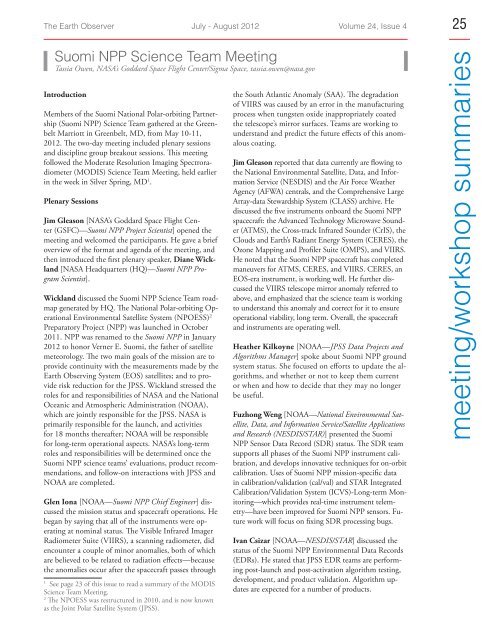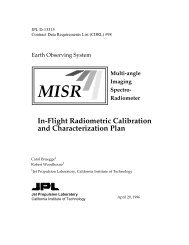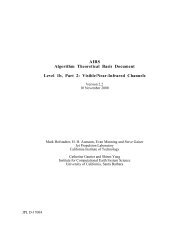Download - NASA's Earth Observing System
Download - NASA's Earth Observing System
Download - NASA's Earth Observing System
Create successful ePaper yourself
Turn your PDF publications into a flip-book with our unique Google optimized e-Paper software.
The <strong>Earth</strong> Observer July - August 2012 Volume 24, Issue 4 25<br />
Suomi NPP Science Team Meeting<br />
Tassia Owen, NASA’s Goddard Space Flight Center/Sigma Space, tassia.owen@nasa.gov<br />
Introduction<br />
Members of the Suomi National Polar-orbiting Partnership<br />
(Suomi NPP) Science Team gathered at the Greenbelt<br />
Marriott in Greenbelt, MD, from May 10-11,<br />
2012. The two-day meeting included plenary sessions<br />
and discipline group breakout sessions. This meeting<br />
followed the Moderate Resolution Imaging Spectroradiometer<br />
(MODIS) Science Team Meeting, held earlier<br />
in the week in Silver Spring, MD 1 .<br />
Plenary Sessions<br />
Jim Gleason [NASA’s Goddard Space Flight Center<br />
(GSFC)—Suomi NPP Project Scientist] opened the<br />
meeting and welcomed the participants. He gave a brief<br />
overview of the format and agenda of the meeting, and<br />
then introduced the first plenary speaker, Diane Wickland<br />
[NASA Headquarters (HQ)—Suomi NPP Program<br />
Scientist].<br />
Wickland discussed the Suomi NPP Science Team roadmap<br />
generated by HQ. The National Polar-orbiting Operational<br />
Environmental Satellite <strong>System</strong> (NPOESS) 2<br />
Preparatory Project (NPP) was launched in October<br />
2011. NPP was renamed to the Suomi NPP in January<br />
2012 to honor Verner E. Suomi, the father of satellite<br />
meteorology. The two main goals of the mission are to<br />
provide continuity with the measurements made by the<br />
<strong>Earth</strong> <strong>Observing</strong> <strong>System</strong> (EOS) satellites; and to provide<br />
risk reduction for the JPSS. Wickland stressed the<br />
roles for and responsibilities of NASA and the National<br />
Oceanic and Atmospheric Administration (NOAA),<br />
which are jointly responsible for the JPSS. NASA is<br />
primarily responsible for the launch, and activities<br />
for 18 months thereafter; NOAA will be responsible<br />
for long-term operational aspects. NASA’s long-term<br />
roles and responsibilities will be determined once the<br />
Suomi NPP science teams’ evaluations, product recommendations,<br />
and follow-on interactions with JPSS and<br />
NOAA are completed.<br />
Glen Iona [NOAA—Suomi NPP Chief Engineer] discussed<br />
the mission status and spacecraft operations. He<br />
began by saying that all of the instruments were operating<br />
at nominal status. The Visible Infrared Imager<br />
Radiometer Suite (VIIRS), a scanning radiometer, did<br />
encounter a couple of minor anomalies, both of which<br />
are believed to be related to radiation effects—because<br />
the anomalies occur after the spacecraft passes through<br />
1<br />
See page 23 of this issue to read a summary of the MODIS<br />
Science Team Meeting.<br />
2<br />
The NPOESS was restructured in 2010, and is now known<br />
as the Joint Polar Satellite <strong>System</strong> (JPSS).<br />
the South Atlantic Anomaly (SAA). The degradation<br />
of VIIRS was caused by an error in the manufacturing<br />
process when tungsten oxide inappropriately coated<br />
the telescope’s mirror surfaces. Teams are working to<br />
understand and predict the future effects of this anomalous<br />
coating.<br />
Jim Gleason reported that data currently are flowing to<br />
the National Environmental Satellite, Data, and Information<br />
Service (NESDIS) and the Air Force Weather<br />
Agency (AFWA) centrals, and the Comprehensive Large<br />
Array-data Stewardship <strong>System</strong> (CLASS) archive. He<br />
discussed the five instruments onboard the Suomi NPP<br />
spacecraft: the Advanced Technology Microwave Sounder<br />
(ATMS), the Cross-track Infrared Sounder (CrIS), the<br />
Clouds and <strong>Earth</strong>’s Radiant Energy <strong>System</strong> (CERES), the<br />
Ozone Mapping and Profiler Suite (OMPS), and VIIRS.<br />
He noted that the Suomi NPP spacecraft has completed<br />
maneuvers for ATMS, CERES, and VIIRS. CERES, an<br />
EOS-era instrument, is working well. He further discussed<br />
the VIIRS telescope mirror anomaly referred to<br />
above, and emphasized that the science team is working<br />
to understand this anomaly and correct for it to ensure<br />
operational viability, long term. Overall, the spacecraft<br />
and instruments are operating well.<br />
Heather Kilkoyne [NOAA—JPSS Data Projects and<br />
Algorithms Manager] spoke about Suomi NPP ground<br />
system status. She focused on efforts to update the algorithms,<br />
and whether or not to keep them current<br />
or when and how to decide that they may no longer<br />
be useful.<br />
Fuzhong Weng [NOAA—National Environmental Satellite,<br />
Data, and Information Service/Satellite Applications<br />
and Research (NESDIS/STAR)] presented the Suomi<br />
NPP Sensor Data Record (SDR) status. The SDR team<br />
supports all phases of the Suomi NPP instrument calibration,<br />
and develops innovative techniques for on-orbit<br />
calibration. Uses of Suomi NPP mission-specific data<br />
in calibration/validation (cal/val) and STAR Integrated<br />
Calibration/Validation <strong>System</strong> (ICVS)-Long-term Monitoring—which<br />
provides real-time instrument telemetry—have<br />
been improved for Suomi NPP sensors. Future<br />
work will focus on fixing SDR processing bugs.<br />
Ivan Csizar [NOAA—NESDIS/STAR] discussed the<br />
status of the Suomi NPP Environmental Data Records<br />
(EDRs). He stated that JPSS EDR teams are performing<br />
post-launch and post-activation algorithm testing,<br />
development, and product validation. Algorithm updates<br />
are expected for a number of products.<br />
meeting/workshop summaries







